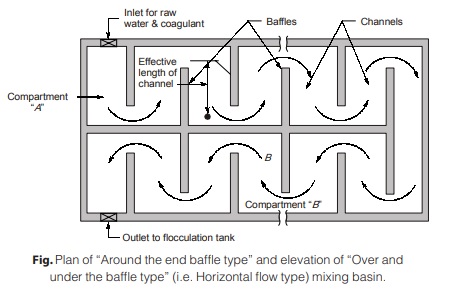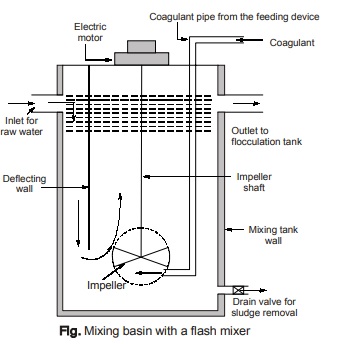Mixing Device
After the addition of the coagulant to the raw water, the mixture is thoroughly and vigorously mixed, so that coagulant gets fully dispersed into the entire mass of water.
This violent agitation of water can be achieved by means of mixing devices, such as:
- Centrifugal pumps
- Compressed air
- Mixing basins
Out of these, mixing basins are most important and normally adopted.
There are two types of mixing basin, as follows:
(a) Mixing Basin with Baffle Walls
The Baffle type mixing basins are rectangular tanks which are divided by baffle walls. The baffle may either be provided in such a way as the water flows horizontally around their ends or they may be provided as to make the water move vertically over and under the baffle. The hindrances and disturbances created by provision of baffles in path of flow, give it sufficient agitation, as to cause necessary mixing to develop the floc. The flocculation energy, is thus, derived primarily from 180° change in direction of flow at each baffle.
The advantage of the baffle basins is their simplicity, because there is no moving equipment and near plug flow conditions occur with low short-circuiting. The disadvantage is that the head loss through such basin is much greater than that in the basin equipped with mechanical mixer. Therefore, baffle type mixing basins are not used in modern days or especially in large plants.
(b) Mixing Basins Equipped with Mechanical Devices
Mixing is done in mixing basin using mechanical mixer. The mechanically agitated mixing basins provide the best type of mixing as the flocculating devices. The chemical added to raw water is vigorously mixed and agitated by a flash mixer for its rapid dispersion in raw water and the water is then transferred to a flocculation tank provided with a slow mixer. A typical flash mixer is shown in figure.
It consists of a rectangular tank which is provided with an impeller fixed to an impeller shaft. The impeller is driven by an electric motor, and it revolves at high speed inside the tank.
The coagulant is brought by the coagulant pipe and is discharged just under the rotating fan. The raw water is separately brought from inlet end and is deflected towards the moving impeller by a deflecting wall. The thoroughly mixed water is taken out from outlet end. The impeller’s speed is generally kept between 100 to 120 rpm. The usual values of detention period may vary between 1/2 to 2 minutes. The raw water and the coagulants are agitated vigorously in a flash mixer. The intensity of mixing depends upon temporal mean velocity (G). G is a measure of relative velocity of two particles of fluid and distance between them:

Design Criteria
- Propeller type impeller is now mostly used in flash mixer.
- Deep circular or square tank is used.
- H / D or B = 1 : 1 to 3 : 1, where D is diameter of tank and B is width of tank.
- Impeller diameter / Tank diameter = 0.2 – 0.4
- Shaft speed is so kept that the tangential velocity greater than 3 m/sec is imparted at the tip of the blade.
Classification of filters
Filters are mainly classified into two types:
- Slows and filter.
- Rapid sand filter
Rapid sand filter can be of two types:
- Gravity type
- Pressure type
The difference between these types of filters lies mainly in
- Head required for filtration
- Rate of filtration
- Composition of filter media
- Method and frequency of cleaning the filter media.
The slow sand filters also known as slow sand gravity filters as they work under the action of gravity are useful in sense that they can remove large percentage of impurities and bacteria from water, as compared to what can be removed by rapid sand filters. However, their rate of filtration is very slow i.e. about 1/30 th of that given by rapid gravity filters and they require very much area. In present times, with the advancement of new disinfection techniques, high efficiency of bacteria removal from filters as given by slow sand filter is not necessary. Therefore, use of slow sand filters is very limited now-a-days.
<< Previous | Next >>
Must Read: What is Environmental Engineering?

